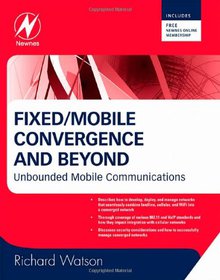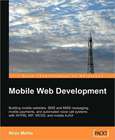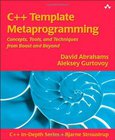Fixed/Mobile Convergence and Beyond
Unbounded Mobile Communications

Book Details:
| Publisher: | Newnes |
| Series: | Newnes |
| Author: | Richard Watson |
| Edition: | 1 |
| ISBN-10: | 0750687592 |
| ISBN-13: | 9780750687591 |
| Pages: | 288 |
| Published: | Oct 23 2008 |
| Posted: | Nov 19 2014 |
| Language: | English |
| Book format: | |
| Book size: | 4.83 MB |
Book Description:
Mobile communications users are demanding increased reliability, functionality, and accessibility; they want "always on" access to voice, e-mail, text, and multimedia services as they roam from home to auto to office to outdoor/indoor locations. In addition, there is an increasing deamnd to replace separate landline/mobile telephones with a single handset that can be used wherever its owner might be. Answering those customer needs, fixed/mobile convergence (FMC) marries the mobility provided by cellular networks with the extended connectivity provided by 802.11-based WiFi services and integrates them with landline networks using a single handset. This book provides the theoretical and practical background necessary to successfully plan, develop, and deploy effective FMC networks.This book discusses the various 802.11 and VoIP protocols used in FMC networks, open and proprietary communications protocols, integration of FMC networks to wired telephone networks, mobilizing applications such as text messaging and video, security issues, mobile handset requirements for FMC networks, and the administration/management of FMC networks. Special attention is given to selecting appropriate components for FMC, and numerous case histories and examples from the author's experience are provided.This book is an essential tutorial and reference for any RF/wireless, communications, and networking professional who will work with the next generation of wireless networks.CONTENTS:Chapter 1 Unbounded Mobile CommunicationsChapter 2 Mobile Communications - State of the TechnologyChapter 3 Unbounded Mobile Communications - what is it?Chapter 4 UMC - an overview of the technology requirements & considerationsChapter 5 UMC - Current Market Solution OverviewChapter 6 UMC - Layer 1 & 2 - Media requirementsChapter 7 VoIP - Layer 3 & 4, the IP infrastructureChapter 8 Voice Optimized Networks - the network orphanChapter 9 Mobile Handset SolutionsChapter 10 Hotspot & Hotzone AccessChapter 11 Security considerationsChapter 12 PBX features & integrationChapter 13 UMC Management and Statute conformance considerationsChapter 14 Mobilizing applicationsChapter 15 The Final Challenge - Sales/support channel considerationsChapter 16 Unbounded mobile communications - beyond FMCGlossary KEY FEATURES* Describes how to develop, deploy, and manage networks that seamlessly combine landline, cellular, and WiFi networks into one converged communications network.* Thorough coverage of various 802.11 and voice over internet protocol (VoIP) standards and how they impact integration with cellular networks.* Discusses security considerations and how to successfully manage converged networks.* Includes numerous case histories and examples from the author's experience---this is not a purely theoretical treatment of the subject!
Download Link:
Related Books:
Deploying IPv6 in 3GPP Networks
Evolving Mobile Broadband from 2G to LTE and Beyond
Deploying IPv6 in 3GPP Networks Evolving Mobile Broadband from 2G to LTE and Beyond A practical guide enabling mobile operators to deploy IPv6 with confidenceThe most widely used cellular mobile broadband network technology is based on the 3GPP standards. The history and background of the 3GPP technology is in the Global Mobile Service (GSM) technology and the work done in European Telecommunications Standards Institute (ETSI). This primary voice service network has evolved to be the dominant mobile Internet access technology.Deploying IPv6 in 3GPP Networks covers how Internet Protocol version 6 (IPv6) is currently defined in the industry standards for cellular mobile broadband, why and how this route was taken in the technology, and what is the cur...
Mobile Web Development
Building mobile websites, SMS and MMS messaging, mobile payments, and automated voice call systems with XHTML MP, WCSS, and mobile AJAX
Mobile Web Development shows you how to build a mobile presence for your web applications and sites. It covers targeting different mobile web browsers, sending and receiving SMS and MMS messages, accepting mobile payments, and developing voice- and touchtone-response systems. This book is for web developers who want to provide mobile support for their applications. The book assumes some knowledge of HTML, CSS, and JavaScript. The reader should also know a server-side language. The examples in the book use PHP, but can be adapted easily to other languages. The book does not use J2ME, focusing instead on using the phone's web browser and other standard features....
C++ Template Metaprogramming
Concepts, Tools, and Techniques from Boost and Beyond
Abrahams and Gurtovoy have written something close to a classic marvelous fun to read Read the complete book review by Jack J. Woehr, Dr. Dobbs Journal, June 03, 2005 "If you're like me, you're excited by what people do with template metaprogramming (TMP) but are frustrated at the lack of clear guidance and powerful tools. Well, this is the book we've been waiting for. With help from the excellent Boost Metaprogramming Library, David and Aleksey take TMP from the laboratory to the workplace with readable prose and practical examples, showing that "compile-time STL" is as able as its runtime counterpart. Serving as a tutorial as well as a handbook for experts, this is the book on C++ template metaprogramming."-Chuck Alliso...
2007 - 2021 © eBooks-IT.org



